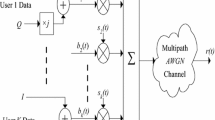Abstract
This paper examines the performance of a multicarrier CDMA system in a Rayleigh fading channel without a RAKE receiver. Since the multicarrier technique is a diversity reception technique used in the frequency domain, the signal is transmitted at different frequency bands and undergoes different fading. The superimposed signal of the multipath components after going through the mobile channel will be processed by an Fourier Transform to enter the frequency domain, where the time delays in various paths are converted to the phase shifts in the compound signal. In this paper, we use sounding bits to extract the characteristics of the mobile channel and to partly remove the multipath effect. From the simulation, it is found that the multicarrier technique is simpler than the technique used in the single carrier system with a RAKE receiver while producing a better performance than that of the RAKE receiver.
Similar content being viewed by others
References
J.A.C. Bingham, “Multicarrier Modulation for Data Transmission: An Idea Whose Time has Come”, IEEE Communications Magazine, Vol. 28, pp. 5–14, 1990.
S. Hara and R. Prasad, “Overview of Multicarrier CDMA”, IEEE Communications Magazine, pp. 126–133, 1997.
S. Kondo and L.B. Milstein, “On the Use of Multicarrier Direct Sequence Spread Spectrum Systems”, in MILCOM'93, 1993, pp. 52–56.
N. Yee, J.P. Linnartz and G. Fettweis, “Multi-Carrier CDMA in Indoor Wireless Radio Networks”, IEICE Transaction on Communication, Vol. E77-B, pp. 900–904, 1994.
N. Yee and J.P. Linnartz, “Controlled Equalization of Multi-Carrier CDMA in an Indoor Rician Fading Channel”, in IEEE Vehicular Technology Conference, 1994, pp. 1665–1669.
J.K. Cavers, “An Analysis of Pilot Symbol Assisted Modulation for Rayleigh Fading Channels”, IEEE Transactions on Vehicular Technology, Vol. 40, pp. 686–693, 1991.
Q. Chen, E.S. Sousa and S. Pasupathy, “Performance of Coded Multi-Carrier DS-CDMA System in Multi-Path Fading Channels”, Wireless Personal Communications, Vol. 2, pp. 167–183, 1995.
C. Loo and N. Secord, “Computer Models for Fading Channels with Applications to Digital Transmission”, IEEE Transaction on Vehicular Technology, Vol. 40, No. 4, pp. 700–707, 1991.
J.G. Proakis, Digital Communications, McGraw-Hill, Inc., 1989.
“Radio Transmission and Reception”, in Recommendation GSM 05.05, October 1993.
Author information
Authors and Affiliations
Rights and permissions
About this article
Cite this article
Yue, J., Do, M.A. Performance of a Multicarrier CDMA System with Rayleigh Fading Multipath Channels. Wireless Personal Communications 18, 93–105 (2001). https://doi.org/10.1023/A:1011230108611
Issue Date:
DOI: https://doi.org/10.1023/A:1011230108611




